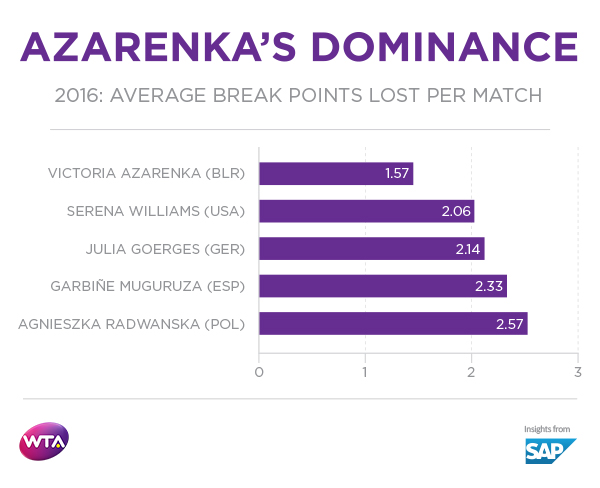The Numbers Behind Azarenka's Renaissance
Victoria Azarenka’s resurgence has been one of the top storylines of the 2016 season. Having started the season at No.22, Azarenka is back up to No.5 after compiling a 24-1 record and winning three of the biggest titles of the season, the BNP Paribas Open, Miami Open, and Brisbane International.
The sole blemish on her record came at the Australian Open, where she lost to eventual champion Angelique Kerber. Through the first four months of the season she sits at No.2 on the Road to Singapore leaderboard. In every way it’s been a near-flawless season so far for Vika.
But why and how? What’s changed aside from the general sense that she’s just playing better tennis this year?
With the help of SAP, we took a closer look at Azarenka’s key stats so far in 2016 and compared them with her historical year-over-year performance since 2008. As the numbers show, her efficiency has been off the charts.
Azarenka leads the tour in return games won
On its face, this is no surprise. Azarenka is one of the best returners in the game and so far in 2016 she has broken her opponent’s serve 54.3% of the time. In her peak years of 2012 and 2013, when she rose to No.1 and won back-to-back Australian Open titles, she finished each season as the tour leader in breaks. In 2012 she broke at a rate of 52.5% and she bettered that mark in 2013, breaking 54.8% of the time.
“I felt that I got stronger than I was before,” Azarenka said of her improved return game. “Definitely on my forehand side I’m able to create more angles, able to create more winners, and put a lot more pressure with that. I think that was one of the more visible improvements of my return.”
Since the WTA began tracking the stat in 2008, only two players have finished the season breaking in more than half of their return games. Azarenka did it twice in 2012 and 2013 and Sara Errani finished 2015 at 51.9%.
Azarenka’s serve has been the most effective on tour
The more interesting story comes after a closer look at Azarenka’s serving numbers. She has never been known for a particularly powerful serve but it’s clear the work she and her team have put into her serve has paid off, especially on second serve. Historically that has been a weaker shot for Azarenka, with her opponents aware that they would have their chances to break.
That hasn’t been the case in 2016. Azarenka leads the tour in service holds at 82.4%, outpacing the No.2 player on the list, Serena Williams, who has held 79.4% of the time. Azarenka’s current hold rate outpaces her previous career-best by over 7%. Her previous best came in 2012 when she held 75% of the time.

To be clear: Azarenka hasn’t morphed into an ace machine. In 23 matches she has hit 60 aces. By comparison, Serena Williams, Karolina Pliskova, Kristyna Pliskova, and Timea Babos have already eclipsed 100 aces on the season so far. But Azarenka has been going for more on her serve in general and taking more risk on her second serve. She already has 95 double faults (74 at WTA Tournaments), the second-most on tour. But her reaction to the rash of double faults has not been to pull back and go for less.
“I worked a lot on my serve to be able to create easier serving games and going for my shots, developing power speed, and now need to work a little bit more on accuracy,” she said earlier in the year.
“I think the serve percentage – I always had a pretty high first serve percentage,” Azarenka said at the Miami Open. “I think the difference is the way I’m using my serve. I’m going for a lot more; I take a lot more risk.”
Azarenka has been taking more risk but her serve has come through during clutch moments. Of her 74 double faults at WTA tournaments, 58 came when she was either ahead or neutral in the scoreline. Four times this year she has double faulted to hand a break away, twice at 30-40, once at 15-40, and once on her opponent’s advantage. Compare that to 2015, when during the same timespan she double-faulted 16 times.
“It’s been more rewarding in terms of winning percentage as opposed to making percentage of serves in,” she said. “If you compare to Australia it’s a big difference from Indian Wells and here. Really trying to work on it and make adjustments to use it more as a weapon. I think that’s been missing for a long, long time to really take my game to next level. I’m glad I have team around me to push me, to learn to trust myself, and really take that and improve it.”

The big question is whether Azarenka can hold these numbers on clay, where breaking serve is easier and holding serve is at a premium. Of her 20 career titles only one has come on clay. But that statistic may be misleading with respect to Azarenka’s prowess on the surface. Her last five losses on the red dirt have come to either Serena Williams or Maria Sharapova, the two best clay-court players of the last four years.
Azarenka returns to action at the Mutua Madrid Open, where she is a two-time finalist. Her French Open preparation continues at the Internazionali BNL d’Italia, where she made the final in 2013.



